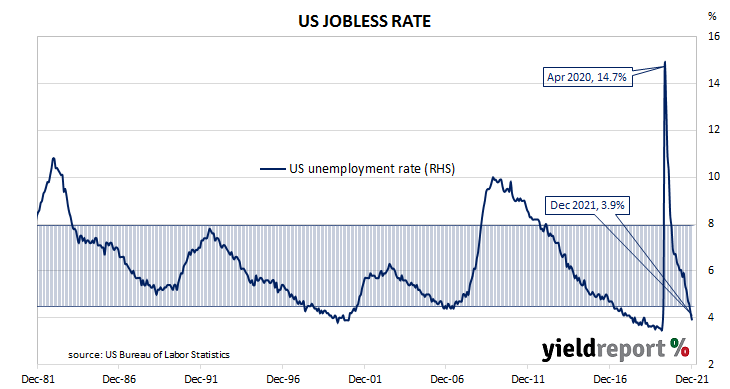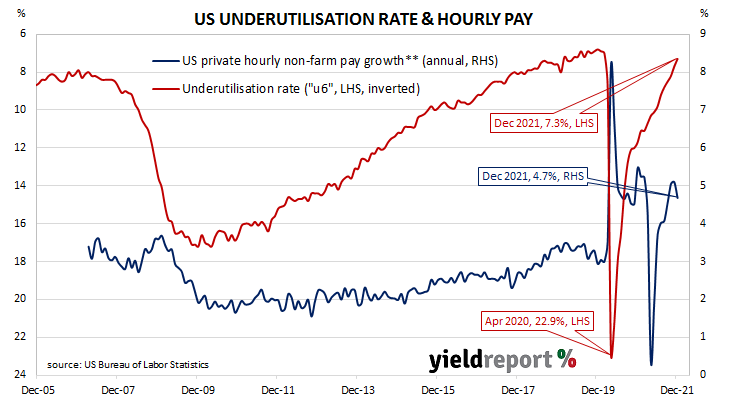Summary: Non-farm payrolls increase by 199K in December; considerably less than 450K expected; previous two months’ figures revised up by 141K; jobless rate down to 3.9%, participation rate revised up to 61.9%; inflationary pressures building “rapidly” in US jobs market; jobs-to-population ratio increases to 59.5%; underutilisation rate falls from 7.7% to 7.3%; annual hourly pay growth slows to 4.7%; lack of available employees “adding to underlying inflation pressures.”
The US economy ceased producing jobs in net terms as infection controls began to be implemented in March 2020. The unemployment rate had been around 3.5% but that changed as job losses began to surge through March and April of 2020. The May 2020 non-farm employment report represented a turning point and subsequent months provided substantial employment gains. Changes in recent months have been generally more modest but usually well above the long-term monthly average.
According to the US Bureau of Labor Statistics, the US economy created an additional 199,000 jobs in the non-farm sector in December. The increase was considerably less than the 450,000 which had been generally expected earlier in the week and not quite as large as 249,000 jobs which had been added in November after revisions. However, employment figures for October and November were also revised up by a total of 141,000.
The total number of unemployed decreased by 483,000 to 6.319 million while the total number of people who are either employed or looking for work increased by 168,000 to 162.294 million. These changes led to a fall in the US unemployment rate from November’s 4.2% to 3.9%. The participation rate remained unchanged from November’s revised rate of 61.9% after it was revised up from 61.8%.
“The fall in the unemployment rate and rise in earnings show inflationary pressures are building rapidly in the labour market,” said ANZ economist Hayden Dimes.
Longer-term US Treasury yields rose moderately on the day. By the close of business, 10-year and 30-year yields had each gained 4bps to 1.77% and 2.12% respectively. The 2-year yield finished unchanged at 0.87%.
In terms of US Fed policy, expectations of any change in the federal funds range over the next 12 months softened slightly. January 2023 futures contracts implied an effective federal funds rate of 0.92%, 84bps above the spot rate but 2bps lower than at the end of the previous day.
One figure which is indicative of the “spare capacity” of the US employment market is the employment-to-population ratio. This ratio is simply the number of people in work divided by the total US population. It hit a cyclical-low of 58.2 in October 2010 before slowly recovering to just above 61% in late-2019. December’s reading increased from 59.3% to 59.5%, still some way from the April 2000 peak reading of 64.7%.
Wage growth spiked in the US during the early stages of pandemic restrictions as lower-paid jobs disappeared at a faster rate relative to higher-paid jobs, disrupting the usual relationship between wage inflation and unemployment rates. Normally, wages tend to grow as the supply of labour tightens.
Apart from the unemployment rate, another measure of tightness in the labour market is the underutilisation rate. In December, this measure fell from 7.7% after revisions to 7.3%. Wage inflation and the underutilisation rate usually have an inverse relationship but this month hourly pay growth in the 12 months to December slowed from November’s revised rate of 5.1% to 4.7%.
Dimes noted total employment in the US is still short of the pre-pandemic peak but a lack of available employees was “adding to underlying inflation pressures.”



